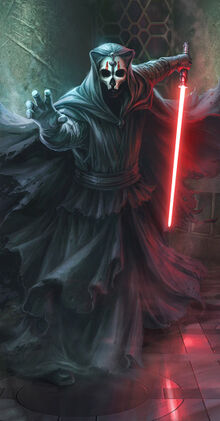
Darth Nihilus in a primary Atra-Manua attack stance.
Who'd ever heard of a Sith lightsaber form that's defensive? And on top of that, it was made by Jasca! What's going on in this galaxy?
—Kyle Katarn
Form DCLXVI: Atra-Manua or the Way of the Black Hand, the Art of the Black Hand (simply known as Atra to its practitioners) was the primary lightsaber form for the Hand during the Successors War.
Despite it's relatively short history, Atra-Manua had an immense affect on the history of the galaxy during the Legacy and Unity era's. Many considered it somewhat unbelievable that, not only was Atra-Manua a defensive form, but that it was a defensive form created by Jasca Ducato.
Duel: A history of the lightsaber within the Sith Order of Decreto was noted as being the only licensed book within the Sith Order of Decreto that described any of the basic stances of Atra-Manua, so that pupils could learn. The result of this was that by the Zao tenj War, the vast majority of Sith had mastered at least the basics of the form, proving all the more formidable in their war against the Zao tenj.
History[]
Although originally an experimental form created by the Jedi Knight Jasca Ducato, Atra-Manua was instantly recognized as one of the hardest forms to master. Following Jasca's fall to the dark side, the new Darth Abeonis decided that he would not teach the form to his followers so that they could not challenge him in a duel effectively.
However he did realize that if he remained the only practitioner of the form that it would die out, yet he was still reluctant to even contemplate teaching it to another. And so it would remain until the year 74 ABY when a Sith Knight and hand named Darth Krayt requested tutelage in the form from his Emperor. Although reluctant at first, Abeonis realized that this was the chance to secure the survival of the combat form for years to come, and he agreed on the condition that Krayt didn't even mention that he was being trained in the form. Krayt agreed, and his training began.
Securing the line[]
And so, for many years it would be that only two men in the entire galaxy knew the Atra-Manua form — Abeonis and Krayt. By the year 189 ABY Krayt had been informed that Abeonis would be training more hands in the form, and so began the training of Darth Wyyrlok.
Following the death of Darth Abeonis in 121 ABY it was widely known amongst the "hand" that Atra-Manua was by far the most practiced lightsaber form amongst their ranks.
Practitioners of the form included Darth Nihl and Darth Talon, as well as Krayt, Proditor and Wyyrlok. With so many practitioners it was hard to even think that the form was at risk of dying out. In fact the form was so successful that — by the Zao tenj War — it was the only form taught to the hand during their training.
Each practitioner added his or her own preferences to the from making it an extremely dangerous form, and very difficult to learn. Darth Nihilus was widely considered the most practiced in the form during the Zao tenj War, something further supported by his skills shown during the battles of Korriban and Yavin IV (although Nihilus knew that his knowledge of Atra-Manua was limited compared to his Emperor Darth Wyyrlok).
Techniques[]
Atra-Manua was regarded as one of the most difficult, but most powerful lightsaber forms to learn. Highly regarded by its practitioners, many considered it the ultimate lightsaber form and some focused their entire lives around attempting to become the most powerful in the art.
Attacking[]
Atra-Manua was considered by most to be an entirely offensive form, and although this was not the case, the art did focus heavily on offense. The main targets were the limbs and the neck.
Masters of Atra-Manua such as Abeonis during the Sith Crusade and later Wyyrlok and Nihilus during the Zao tenj War taught that while the main focus of lightsaber combat was to slaughter you opponent (in their view at least), Atra-Manua was traditionally a combative form designed to incapacitate an opponent without killing them, instantly at least. The problem with this was that Atra-Manua relied less on use of "the Force" than it did on the practitioner's combative skill.
Practitioners were taught that they should learn to effective duel without using the Force, so that when they did they would become masters of the art.
Sai cha[]
Sai cha was the act of beheading an opponent. Although Atra-Manua taught against this act, during the Successors and Zao tenj War it became one of the main offensive maneuver used by the hand.
Darth Krayt perfected the much more dangerous maneuver of Sai tok, the act of cutting an opponent in half. A favorite attack of Krayt's, he used it many-a-time during the Successors War. It was the attack used by Darth Nihl to kill Berrek Verk.
Shiim[]
Shiim was by far the most common maneuver of Atra-Manua as it only called upon the combatant to wound their opponent, not kill them.
Mou kei[]
Mou kei, the most dangerous, and frowned upon maneuver of Atra-Manua called upon the practitioner to dismember all the limbs of their opponent in one circular action.
Rarely used due to its extreme difficulty, it left the attacker open and thus vulnerable.
Defense[]
Although believed by many to be an entirely offensive lightsaber form, Atra-Manua did contain a moderate amount of defensive maneuver. Although Atra-Manua had a fair amount of purely defensive forms, the vast majority of its defenses merged into an attack of some form.
Behind the scenes[]
The words Atra Manua(lis) are a directly translated from Latin into English as "fitted to a dead black hand". The Roman numerals DCLXVI equal the Arabic numerals "666".
